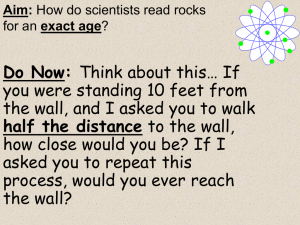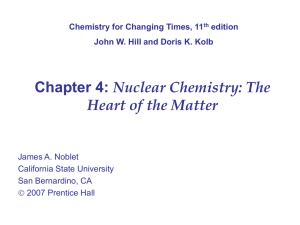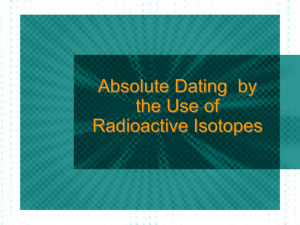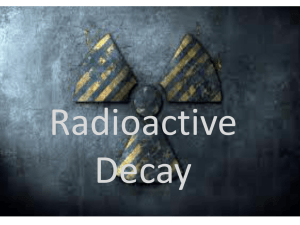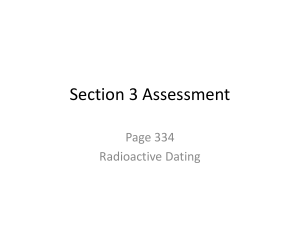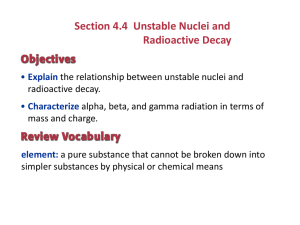Radiochemical Methods - Pace University Webspace
advertisement
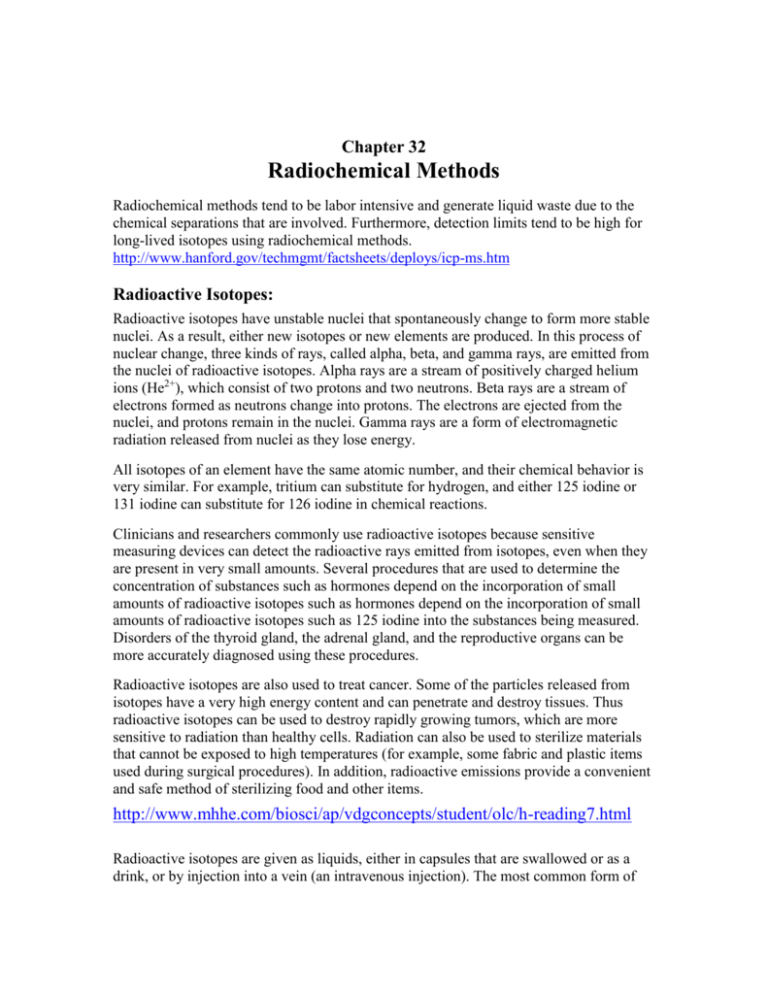
Chapter 32 Radiochemical Methods Radiochemical methods tend to be labor intensive and generate liquid waste due to the chemical separations that are involved. Furthermore, detection limits tend to be high for long-lived isotopes using radiochemical methods. http://www.hanford.gov/techmgmt/factsheets/deploys/icp-ms.htm Radioactive Isotopes: Radioactive isotopes have unstable nuclei that spontaneously change to form more stable nuclei. As a result, either new isotopes or new elements are produced. In this process of nuclear change, three kinds of rays, called alpha, beta, and gamma rays, are emitted from the nuclei of radioactive isotopes. Alpha rays are a stream of positively charged helium ions (He2+), which consist of two protons and two neutrons. Beta rays are a stream of electrons formed as neutrons change into protons. The electrons are ejected from the nuclei, and protons remain in the nuclei. Gamma rays are a form of electromagnetic radiation released from nuclei as they lose energy. All isotopes of an element have the same atomic number, and their chemical behavior is very similar. For example, tritium can substitute for hydrogen, and either 125 iodine or 131 iodine can substitute for 126 iodine in chemical reactions. Clinicians and researchers commonly use radioactive isotopes because sensitive measuring devices can detect the radioactive rays emitted from isotopes, even when they are present in very small amounts. Several procedures that are used to determine the concentration of substances such as hormones depend on the incorporation of small amounts of radioactive isotopes such as hormones depend on the incorporation of small amounts of radioactive isotopes such as 125 iodine into the substances being measured. Disorders of the thyroid gland, the adrenal gland, and the reproductive organs can be more accurately diagnosed using these procedures. Radioactive isotopes are also used to treat cancer. Some of the particles released from isotopes have a very high energy content and can penetrate and destroy tissues. Thus radioactive isotopes can be used to destroy rapidly growing tumors, which are more sensitive to radiation than healthy cells. Radiation can also be used to sterilize materials that cannot be exposed to high temperatures (for example, some fabric and plastic items used during surgical procedures). In addition, radioactive emissions provide a convenient and safe method of sterilizing food and other items. http://www.mhhe.com/biosci/ap/vdgconcepts/student/olc/h-reading7.html Radioactive isotopes are given as liquids, either in capsules that are swallowed or as a drink, or by injection into a vein (an intravenous injection). The most common form of radioisotope treatment is radioactive iodine. Used to treat tumours of the thyroid gland, it is given as an odourless and colourless drink. The same safety precautions are taken with this type of treatment as for radioactive sources. Any radioactive-iodine that is not absorbed by the thyroid will be passed from the body in sweat and urine. You should drink plenty of fluids during your treatment as this helps to flush the iodine out of the body. The amount of radiation in your body will be checked regularly and as soon as it falls to a safe level, after about four to seven days, you will be able to go home. You may need to take some special precautions for a short time after going home - particularly with regard to young children and pregnant women. The hospital staff will explain these to you. Radioactive iodine does not usually cause side effects, but you may feel very tired for a few weeks after having this treatment. Radioisotope treatment can also be given if certain types of cancer have spread to the bones (secondary cancer in the bone). A radioisotope is injected into a vein, for which you can attend as an out-patient. Before you go home you will be given some simple advice to follow, as your urine and blood will be slightly radioactive for a few days. This type of radiotherapy treatment does not usually cause any side effects, apart from tiredness for a few weeks. http://www.cancerbacup.org.uk/Treatments/Radiotherapy/Radiotherapy/Rad ioactiveisotopes The presence of both natural and artificial radioactive isotopes has made possible the development of analytical methods that are both sensitive and specific. Radiochemical methods are characterized by good accuracy and their ability to be adapted to a wide number of applications. Another advantage to this method is that they minimize or even eliminate the need for separations that are required in other analytical methods. A numerical (or "absolute") age is a specific number of years, like 150 million years ago. A relative age simply states whether one rock formation is older or younger than another formation. The Geologic Time Scale was originally laid out using relative dating principles. Numerical dating takes advantage of the "clocks in rocks" - radioactive isotopes ("parents") that spontaneously decay to form new isotopes ("daughters") while releasing energy. For example, decay of the parent isotope Rb-87 (Rubidium) produces a stable daughter isotope, Sr-87 (Strontium), while releasing a beta particle (an electron from the nucleus). ("87" is the atomic mass number = protons + neutrons. Numerical ages have been added to the Geologic Time Scale since the advent of radioactive age-dating techniques. Many minerals contain radioactive isotopes. In theory, the age of any of these minerals can be determined by: 1) Counting the number of daughter isotopes in the mineral, and 2) Using the known decay rate to calculate the length of time required to produce that number of daughters. It illustrates how the amount of a radioactive parent isotope decreases with time. This amount is a percentage of the original parent amount. Time is expressed in half-lives. Experiment by dragging on the graph. For example when 42% of the parent still remains, 1.23 Half-Lives of time has passed. Parent Decay and Daughter Growth Curves: The half-life of U-235 decaying to Pb-207 is 713 million years. Note that this half-life can be obtained from the graph at the point where the decay and growth curves cross. Radiocarbon Dating: Willard F. Libby and a team of scientists at the University of Chicago developed the radiocarbon dating method in the 1940’s. It subsequently evolved into the most powerful method of dating late Pleistocene and Holocene artifacts and geologic events up to about 50,000 years in age. The radiocarbon method is applied in many different scientific fields, including archeology, geology, oceanography, hydrology, atmospheric science, and paleoclimatology. For his leadership, Libby received the Nobel Prize in Chemistry in 1960.h http://www.earthsci.org/geotime/radate/radate.html There are three types of radiochemical methods: 1. 2. 3. Activation analysis. The activity is induced in one or more elements of the sample by irradiation with suitable radiation or particles. Most commonly thermal neutrons from a nuclear reactor source is used. Tracer method. Radioactivity is introduced into the sample by adding a measured amount of a radioactive species. Isotope dilution. This method is the most important class of radiochemical quantitative method. In this method, a weighed quantity of radioactively tagged analyte having a known activity is added to a measured amount of sample. The mixture is then mixed to homogeneity and then a fraction of the compound of interest is isolated and purified. The analysis is based upon the activity of the isolated fraction. All atoms, except hydrogen, is made up of a collection of protons and neutrons. The chemical properties of an atom are determined by its atomic number, Z, the number of protons. The sum of neutrons and protons is the mass number, A. The nuclei of isotopes of an element contain the same number of protons, but have different numbers of neutrons. Stable isotopes are those that decay spontaneously. Radioactive isotopes (radionuclides), undergo spontaneous disintegration, which ultimately leads to stable isotopes. Radioactive decay of isotopes occurs with the emission of electromagnetic radiation in the form of x-rays or gamma ray. Accompanying this emission is the formation of electrons, positrons and the helium nucleus or fusion in which a nucleus breaks up into smaller nuclei. Some of the most chemically important types of radiation from radioactive decay are listed in the table. Four types of these types - alpha particles, beta particles, gamma-ray photons and X-ray photons can be detected and counted. Product Alpha particle Beta particles Negatron Positron Gamma ray X-Ray Neutron Neutron Symbol Charge +2 Mass Number 4 + n v -1 +1 0 0 0 0 1/1840 (~0) 1/1840 (~0) 0 1 0 Alpha Decay: Alpha decay is a common radioactive process encountered with heavier isotopes. The alpha particle is a helium nucleus having a mass of 4 and a charge of +2. Isotopes with mass numbers less than about 150 (Z 60) seldom yield alpha particles. Alpha particles progressively lose their energy as a result of collisions as they pass through matter and are ultimately converted into helium atoms through capture of two electrons from their surroundings. Since alpha particles have high mass and charge, alpha particles have a low penetrating power. Because of this, alpha particles are relatively ineffective for producing artificial isotopes. An example of alpha decay is shown by the equation below: 238 U 92 234 Th 90 + 4 He 2 Here, uranium-238 is converted to thorium-234 a daughter nuclide having an atomic number that is two less than the parent. Alpha particles from a particular decay process are either monoenergetic or are distributed among relatively few discrete energies. As shown above, the decay process proceeds by two distinct pathways. The first, which accounts for 77% of the decays, produces an alpha particle with an energy of 4.196MeV. The second pathway produces an alpha particle having an energy of 4.149MeV. Alpha Decay http://education.jlab.org/glossary/alphadecay.html Beta Decay: Beta decay is a radioactive process in which, the atomic number changes but the mass number stays the same. There are types of decay are encountered: negatron formation, positron formation and electron capture. Example of these three process are: 14 6 C147 N - v negatron formation 65 30 65 Zn 29 Cu v 48 24 positron formation Cr e V X rays electron capture 0 1 48 23 Here v and v in the first two equations represent an antineutrino and a neutrino particle of no significance in analytical chemistry. The third equation illustrates a beta-decay process called electron capture. Negatrons (-) are electrons that form when one of the neutrons in the nucleus is converted to a proton. A positron (+), with the mass of the electrons forms when the number of protons in the nucleus is decreased by one. In contrast to alpha emission, beta emission is characterized by the production of a continuous spectrum of energies ranging from nearly zero to some maximum that is characteristic for each decay process. The beta particle is not nearly as effective as the alpha particle in producing ion pairs in matter because of its small mass (about 1/7000 that of an alpha particle). The penetrating power of beta particles is substantially higher. Beta Radioactivity Beta particles are just electrons from the nucleus, the term "beta particle" being an historical term used in the early description of radioactivity. The high-energy electrons have greater range of penetration than alpha particles, but still much less than gamma rays. The radiation hazard from betas is greatest if they are ingested. Beta emission is accompanied by the emission of an electron antineutrino, which shares the momentum, and energy of the decay. The emission of the electron's antiparticle, the positron, is also called beta decay. Beta decay can be seen as the decay of one of the neutrons to a proton via the weak interaction. The use of a weak interaction Feynman diagram can clarify the process. http://hyperphysics.phy-astr.gsu.edu/hbase/nuclear/beta.html Gamma-Ray Emission: Gamma rays are produced by nuclear relaxations. Gamma-ray emission is the result of a nucleus in an excited state returning to the ground state in one or more quantized steps with the release of monoenergetic gamma rays. Gamma rays, except for their source, are indistinguishable from X-rays of the same energy. The gamma-ray emission spectrum is characteristic for each nucleus and is thus useful for identifying radioisotopes. Gamma radiation is highly penetrating. Gamma rays in interacting with matter lose energy by three mechanisms; the one that predominates depends upon the energy of the gamma-ray photon. With low-energy gamma radiation, the photoelectric effect predominates. In this interaction, the gamma-ray photon disappears after ejecting an electron from an atomic orbital of the target atom. The photon energy is totally consumed in overcoming the binding energy of the electron and in overcoming the binding energy of the electron and in imparting kinetic energy to the ejected electron. Relatively energetic gamma interacts via the Compton effect. In this, an electron is also ejected from an atom but acquires only a part of the photon energy. The photon now with diminished energy, recoiled from the electron and goes on to further Compton or photoelectric interactions. If the gammaray photon possesses sufficiently high energy (at least 1.02 MeV), pair production can occur. In this scenario the photon is totally absorbed in creating a positron and an electron in the field surrounding a nucleus. Paul Villard, a French physicist, is credited with discovering gamma rays. Most sources put this in 1900, although I've seen a few sources use 1898. Villard recognized them as different from X-rays (discovered in 1896 by Roentgen) because the gamma rays had a much greater penetrating depth. It wasn't until 1914 that Rutherford showed that they were a form of light with a much shorter wavelength than X-rays. Gamma rays are more dangerous than radio waves. This is due to the fact that light can be thought of as particles (photons) as well as electromagnetic waves. A radio photon doesn't have much energy and doesn't travel through matter well (that's why you don't pick up radio well in a tunnel). A gamma-ray photon has enough energy to damage atoms in your body and make them radioactive, and gamma rays can easily penetrate into your body. It's like the difference between getting hit by sand or a bullet. It takes a lot of sand to do any damage, but only one bullet. http://imagine.gsfc.nasa.gov/docs/ask_astro/answers/980209c.html X-Ray Emission: X-Ray emission is formed from electronic transitions in which outer electrons fill the vacancies created by the nuclear process. One of the processes is electron capture. A second process which may lead to X-rays is internal conversion, a type of nuclear process that is an alternative to gamma-ray emission. In this process, an electromagnetic interaction between the excited nucleus and an extranuclear electron results in the ejection of an orbital electron with a kinetic energy equal to the difference between the energy of the electron. The emission of this so-called internal conversion electron leaves a vacancy in the K, L or higher orbitals. X-rays are emitted as the orbital is filled by an electronic transition. On the earth, we generate the energetic particles in analytical instruments such as the scanning electron microscope (called an electron microprobe) and measure the energies of the X-rays emitted from the sample. The general concept: electrons are knocked out of occupied levels by energetic X-rays, electrons, or ions (either protons - H+ - or alpha particles - He++), electrons make transitions from filled to empty states and emit an X-ray. The energy of the emitted characteristic X-ray identifies the atom. http://acept.la.asu.edu/PiN/rdg/pixe/pixe.shtml Radioactive Decay Rates: Radioactive decay is a completely random process. Although no predictions can be made concerning the lifetime of an individual nucleus, the behavior of a large ensemble of like nuclei can be described by the first order rate expression. dN N dt where N is the number of radioactive nuclei of a particular kind in the sample at time t and is the decay constant for the particular radioisotope. Over this interval this expression can be rearranged to N N 0 e kt The half-life, t½ is t 12 ln 2 0.693 The half-lives of radioactive species range from small fractions of a second to many billions of years. The activity A or a radionuclide is defined by its disintegration rate. A dN N dt Activity is given in units of s-1. The becquerel (Bq) corresponds to 1 decay per second (1 Bq = 1 s-1). An older, but still widely used unit of activity is the Curie (Ci), which was originally defined as the activity of 1 g of radium-226. One curie is equal to 3.70 1010 Bq. In analytical radiochemistry, activities of analytes range from a nanocurie to less to a few microcuries. In the laboratory, solution activities are seldom measured because detection efficiencies are seldom 100%. Instead, the counting rate, R is employed, where R = cA Substituting this into the activity expression yields R = cN Here, c is constant called the detection coefficient, which depends upon the nature of the detector, the efficiency of counting disintegrations, and the geometric arrangement of sample and detector. The decay law given then can be written as R R0 e kt Radioactivity is measured by means of a detector that produces a pulse of electricity for each atom undergoing decay. Quantitative information about decay rates is obtained by counting these pulses for a specific period. Shown below is a table with decay data obtained by successive one-minute counts. Minutes 1 2 3 4 5 6 Counts 180 187 166 173 170 164 Minutes 7 8 9 10 11 12 Counts 168 170 173 132 154 167 Total counts = 2004 Average counts/min = 167 As discussed earlier, radioactive decay is random. In order to accurately describe radioactive behavior, it is necessary to assume a Poisson distribution, which is given by the equation y x i xi ! e where y is the frequency of occurrence of a given count xi and is the mean for a large set of counting data. The data plotted in the figure below, shows the deviation (xi - ) from the true average count that would be expected if 1000 replicate observations were made on the same sample. Curve A gives the distribution for a substance for which the true average count for a selected period is 5. Curve B and C correspond to samples having the true means of 15 and 35. The absolution deviation becomes greater with increases in , but the relative deviations become smaller. Note that for the two smaller number of counts, the distribution is not symmetric around the average. This lack of symmetry is a consequence of the fact that a negative count is impossible, while a finite probability exists that a given count will exceed the average by severalfold. The confidence interval for a measurement was defined as the limits around a measured quantity within the true mean can be expected to fall with a stated probability. When the measured standard deviation is believed to be a good approximation of the true standard deviation (s ), the confidence limit CL is CL for = x z For counting rates, this equation takes the following form CL for R = R z R where z is dependent upon the desired level of confidence. The relative uncertainties in counting are shown below. The counts recorded in a radiochemical analysis include a contribution from sources other than the sample. Background activity can be traced to the existence of minute quantities of radon isotopes in the atmosphere, to the materials used in construction of the laboratory, to accidental contamination within the laboratory, to cosmic radiation, and to the release of radioactive materials into the Earth’s atmosphere. In order to obtain a true assay, then, it is necessary to correct the total count for background. The counting period required to establish the background correction frequently differs from that for the sample, as a result, it is more convenient to employ counting rates. The standard deviation of the corrected counting rate is R C Rx Rb tx tb where Rc is the corrected counting rate and Rx and Rb are the rates for the sample and the background, respectively. Instrumentation: Radiation from radioactive sources can be detected and measured in essentially the same way as X-radiation. Gas-filled transducers, scintillation counters and semiconductor detectors are all sensitive to alpha and beta particles and gamma rays because absorption of these particles induces ionization or photoelectrons, which can in turn produce thousands of ion pairs. Alpha-emitting samples are generally counted as thin deposits prepared by electrodeposition or by distillation and condensation. These deposits are then sealed with think windows and counted in windowless gas-flow proportional counters or ionization chambers. Liquid scintillation counting is becoming more important for counting alpha emitters because of the ease of sample preparation and the higher sensitivity for alpha-particle detection. For beta sources having energies greater than about 0.2 MeV, a uniform layer of the sample is counted with a thin-windowed Geiger or proportional tube counter. For lowenergy beta emitter, such as carbon-14, sulfur-35 and tritium, liquid scintillation counters are preferable. In a liquid scintillation counter a vial containing the solution is placed between two photomultiplier tubes housed in a light-tight container. The output from the two transducers is fed into a coincidence counter, an electronic device that only records a count only when pules from the two transducers arrive at same. The coincidence counter reduces the background noise from the detector and amplifiers because of the low probability that such noise will affect both systems simultaneously. Gamma radiation is detected and measured by the methods used for the detection for Xradiation. Interference from alpha- and beta- radiation is readily avoided by filtering the radiation with a thin film piece of aluminum or Mylar. Gamma-ray spectrometer is similar to the pulse-height analyzer. The figure below shows a gamma-ray reference spectrum obtained with a 4000 channel analyzer. The characteristic peaks for the various elements are superimposed on the continuum that arises primarily from the Compton effect. The schematic below shows a well-type scintillation counter that is used for gamma-ray counting. Isotope Dilution Method: Isotope dilution methods predate activation procedure and are still being extensively applied to problems in all branches of chemistry. Stable and radioactive isotopes are employed in the isotope dilution technique. The isotope dilution method is more convenient because of the ease with which the concentration of the isotope can be determined. Principles of the Isotope Dilution Procedure: Isotope dilution methods require the preparation of a quantity of the analyte in a radioactive form. A known weight of the isotopically labeled species is then mixed with the sample to be analyzed. After treating to assure homogeneity between the active and nonactive species, a part of the analyte is isolated chemically in the form of a purified compound. By counting a weighed portion of this product, the extent of dilution of the active material can be calculated and related to the amount of nonactive substance in the original sample. The following equation relates the activity of the isolated and purified mixture of analyte and tracer to the original amount of the analyte, Wx Rt W Wt Rm m where, Wx is the grams of tracer having a counting rate of Rt (cpm), Wm is the grams of isolated and purified mixture of active and inactive species with a counting rate of Rm, and Wt is the weight of the tracer. The isotopic dilution technique has been used for the determination of about 30 elements in a variety of matrix materials. Modern Uses of Radioactive Isotopes: Smoke Detectors and Americium-241 How many of us have smoke detectors in our house? Chances are that a great number of homes have had one or more of these devices installed as an early warning system in case of fire. What most consumers don't know is that many of these units contain a small amount of americium-241. By utilizing the radioactive properties of this material, smoke from a fire can be detected at a very early stage. This early warning capability has saved many lives. In fact, studies have shown that 80% of fire injuries and 80% of fire fatalities occur in homes without smoke detectors. Agricultural Applications - radioactive tracers Radioisotopes can be used to help understand chemical and biological processes in plants. This is true for two reasons: 1) radioisotopes are chemically identical with other isotopes of the same element and will be substituted in chemical reactions and 2) radioactive forms of the element can be easily detected with a Geiger counter or other such device. A solution of phosphate, containing radioactive phosphorus-32, is injected into the root system of a plant. Since phosphorus-32 behaves identically to that of phosphorus-31, the more common and non-radioactive form of the element, the plant uses it in the same way. A Geiger counter is then used to detect the movement of the radioactive phosphorus-32 throughout the plant. This information helps scientists understand the detailed mechanism of how plants utilized phosphorus to grow and reproduce. Food Irradiation Food irradiation is a method of treating food in order to make it safer to eat and have a longer shelf life. This process is not very different from other treatments such as pesticide application, canning, freezing and drying. The end result is that the growth of diseasecausing microorganisms or those that cause spoilage are slowed or are eliminated altogether. This makes food safer and also keeps it fresh longer. Food irradiated by exposing it to the gamma rays of a radioisotope -- one that is widely used is cobalt-60. The energy from the gamma ray passing through the food is enough to destroy many disease-causing bacteria as well as those that cause food to spoil, but is not strong enough to change the quality, flavor or texture of the food. It is important to keep in mind that the food never comes in contact with the radioisotope and is never at risk of becoming radioactive. The FDA has approved the irradiation of several food categories, but irradiation is most widely used on spices, herbs and dehydrated vegetables. Since these food items are grown in or on the ground it is clear to see that they are at risk for being exposed to naturally occurring pests such as bacteria, molds, fungi, insects, and rodents. It is impossible to harvest and package these items without having some contamination from these naturally occurring pathogens. Irradiation of this material can help to ensure that the final product you purchase is pest free. Some meats are irradiated. Pork, for example, is irradiated to control the trichina parasite that resides in the muscle tissue of some pigs. Poultry is irradiated to eliminate the chance of foodborne illness due to bacterial contamination. Irradiation of certain foods also has additional benefits. Since the energy passing through the food can disrupt cellular processes (this is the mechanism for destroying microorganisms) it also can halt the cellular processes that lead to the sprouting or ripening of foods. Potatoes and onions are irradiated to retard their sprouting. Fruits and vegetables are irradiated to slow down the ripening process. In this way, delicate fruits won't reach their peak ripeness before they arrive at the supermarket. Food irradiation sounds like a wonderful use of nuclear chemistry principles. Although this process is routinely used in Europe, Canada, and Mexico, the United States has been a little more hesitant to adopt food irradiation. This is due mainly to the public's perceived fear and limited understanding of nuclear science. For example, although the FDA has approved the irradiation of poultry, the industry hesitates to adopt the process because they are afraid of a negative response from consumers. With recent public education, however; many people are learning to appreciate and value its usefulness. Archaeological Dating Significant progress has been made in this field of study since the discovery of radioactivity and its properties. One application is carbon-14 dating. Recalling that all biologic organisms contain a given concentration of carbon-14, we can use this information to help solve questions about when the organism died. It works like this: when an organism dies it has a specific ratio by mass of carbon-14 to carbon-12 incorporated in the cells of its body. (The same ratio as in the atmosphere.) At the moment of death, no new carbon-14 containing molecules are metabolized; therefore the ratio is at a maximum. After death, the carbon-14 to carbon-12 ratio begins to decrease because carbon-14 is decaying away at a constant and predictable rate. Remembering that the half-life of carbon-14 is 5700 years, then after 5700 years half as much carbon-14 remains within the organism. Medical Uses Bone imaging is an extremely important use of radioactive properties. Supposed a runner is experiencing severe pain in both shins. The doctor decides to check to see if either tibia has a stress fracture. The runner is given an injection containing 99Tcm. This radioisotope is a gamma ray producer with a half-life of 6 hours. After a several hour wait, the patient undergoes bone imaging. At this point, any area of the body that is undergoing unusually high bone growth will show up as a stronger image on the screen. Therefore if the runner has a stress fracture, it will show up on the boneimaging scan. This technique is also good for arthritic patients, bone abnormalities and various other diagnostics. http://www.chem.duke.edu/~jds/cruise_chem/nuclear/uses.html Useful Websites Dealing With Instrumental Analysis Chemical Abstracts Service: http://www.cas.org Chemical Center Home Page: http://www.chemcenter/org Journal of Chemistry and Spectroscopy: http://www.kerouac.pharm.uky.edu/asrg/wave/wavehp.html The Analytical Chemistry Springboard at Umea U. http://www.anachem.umu.se/jumpstation.htm Spectrum Chromatography: http://www.lplc.com/ ZirChrom Separations Home Page: http://www.zirchrom.com/ Comprehensive Info on HPLC http://hplc.chem.vt.edu/ Chromatix Chromatography Information Source: http://www.chrom.com/ Chemical and Radiochemical Analysis http://www.gat.com/chemistry Laboratory of radiochemical methods of investigation and analysis of materials http://www.chem.msu.su/eng/lab/radoric.html Analytical Chemistry: Radiochemical Methods. http://www.rohan.sdsu.edu/staff/drjackm/chemistry/chemlin.. Radiochemical Method Group. http://www.rsc.org/lap/rsccom/dab/ana011.htm

